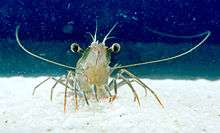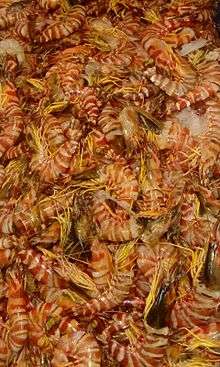Penaeus monodon
| Penaeus monodon | |
|---|---|
 | |
 | |
| Scientific classification | |
| Kingdom: | Animalia |
| Phylum: | Arthropoda |
| Subphylum: | Crustacea |
| Class: | Malacostraca |
| Order: | Decapoda |
| Suborder: | Dendrobranchiata |
| Family: | Penaeidae |
| Genus: | Penaeus |
| Species: | P. monodon |
| Binomial name | |
| Penaeus monodon Fabricius, 1798 | |
| Synonyms [1] | |
| |
Penaeus monodon, commonly known as the giant tiger prawn[1][2] or Asian tiger shrimp[3][4] (and also known by other common names), is a marine crustacean that is widely reared for food.

Taxonomy
Penaeus monodon was first described by Johan Christian Fabricius in 1798. That name was overlooked for a long time, however, until 1949, when Lipke Holthuis clarified to which species it referred.[5] Holthuis also showed that P. monodon had to be the type species of the genus Penaeus.[5]
Description
Females can reach about 33 cm (13 in) long, but are typically 25–30 cm (10–12 in) long and weight 200–320 g (7–11 oz); males are slightly smaller at 20–25 cm (8–10 in) long and weighing 100–170 g (3.5–6.0 oz).[1] The carapace and abdomen are transversely banded with alternative red and white. The antennae are grayish brown. Brown pereiopods and pleopods are present with fringing setae in red.[6]
Distribution
Its natural distribution is the Indo-Pacific, ranging from the eastern coast of Africa and the Arabian Peninsula, as far as Southeast Asia, the Pacific Ocean, and northern Australia.[7]
It is an invasive species in the northern waters of the Gulf of Mexico[4] and the Atlantic Ocean off the southern US.[8]
Aquaculture
Penaeus monodon is the second-most widely cultured prawn species in the world, after only whiteleg shrimp, Litopenaeus vannamei.[1] In 2009, 770,000 tonnes were produced, with a total value of US$3,650,000,000.[1]
Sustainable consumption
In 2010, Greenpeace added Penaeus monodon to its seafood red list – "a list of fish that are commonly sold in supermarkets around the world, and which have a very high risk of being sourced from unsustainable fisheries".[9] The reasons given by Greenpeace were "destruction of vast areas of mangroves in several countries, over-fishing of juvenile shrimp from the wild to supply farms, and significant human rights abuses".[9]
References
| Wikimedia Commons has media related to Penaeus monodon. |
- 1 2 3 4 5 "Species Fact Sheets: Penaeus monodon (Fabricius, 1798)". FAO Species Identification and Data Programme (SIDP). FAO. Retrieved January 10, 2010.
- ↑ "Giant Tiger Prawn". Sea Grant Extension Project. Louisiana State University. Retrieved 2013-09-24.
- ↑ "Penaeus monodon". Nonindigenous Aquatic Species. United States Geological Survey. 2013-06-14. Retrieved 2013-09-24.
- 1 2 Tresaugue, Matthew (2011-12-24). "Giant shrimp raises big concern as it invades the Gulf". Houston Chronicle. Retrieved 2013-09-24.
- 1 2 L. B. Holthuis (1949). "The identity of Penaeus monodon Fabr." (PDF). Proceedings of the Koninklijke Nederlandse Akademie van Wetenschappen. 52 (9): 1051–1057.
- ↑ Motoh, H (1981). "Studies on the fisheries biology of the giant tiger prawn, Penaeus monodon in the Philippines". Biological Reviews. 45: 121–165.
- ↑ L. B. Holthuis (1980). "Penaeus (Penaeus) monodon". Shrimps and Prawns of the World. An Annotated Catalogue of Species of Interest to Fisheries. FAO Species Catalogue. 1. Food and Agriculture Organization. p. 50. ISBN 92-5-100896-5.
- ↑ Fisheries, NOAA. "Invasion of Asian Tiger Shrimp in Southeast U.S. Waters :: NOAA Fisheries". www.nmfs.noaa.gov. Retrieved 3 October 2016.
- 1 2 "Greenpeace International Seafood Red list". Greenpeace. Retrieved February 16, 2010.